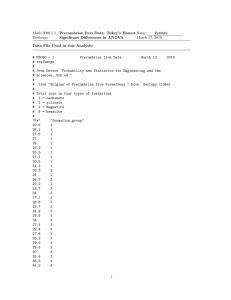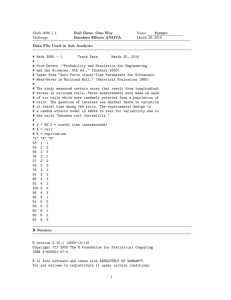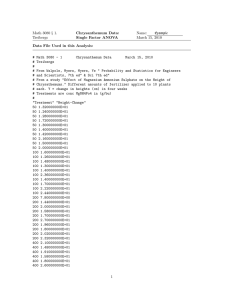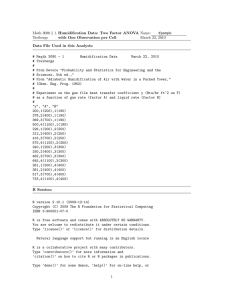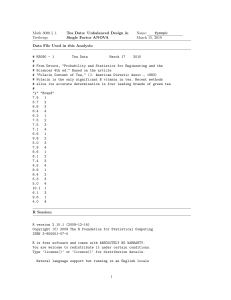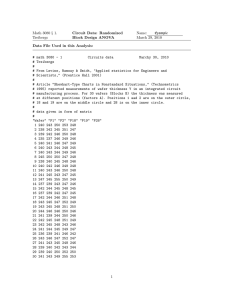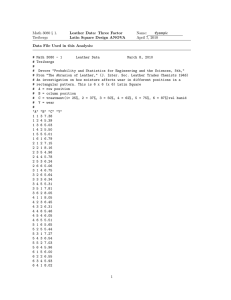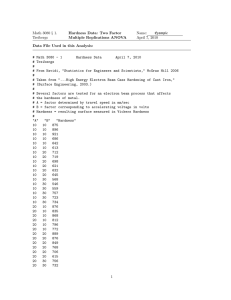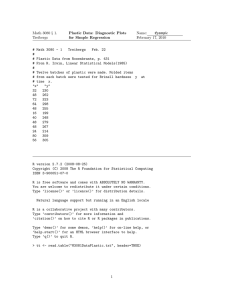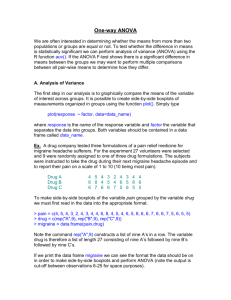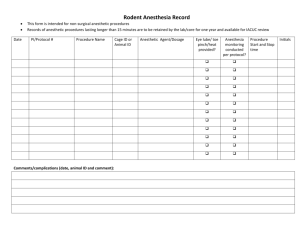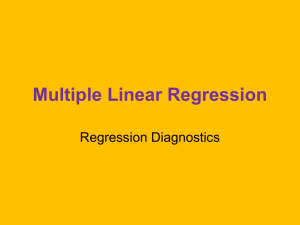Math 3080 § 1. Anesthetic Data: Randomized Name: Example
advertisement
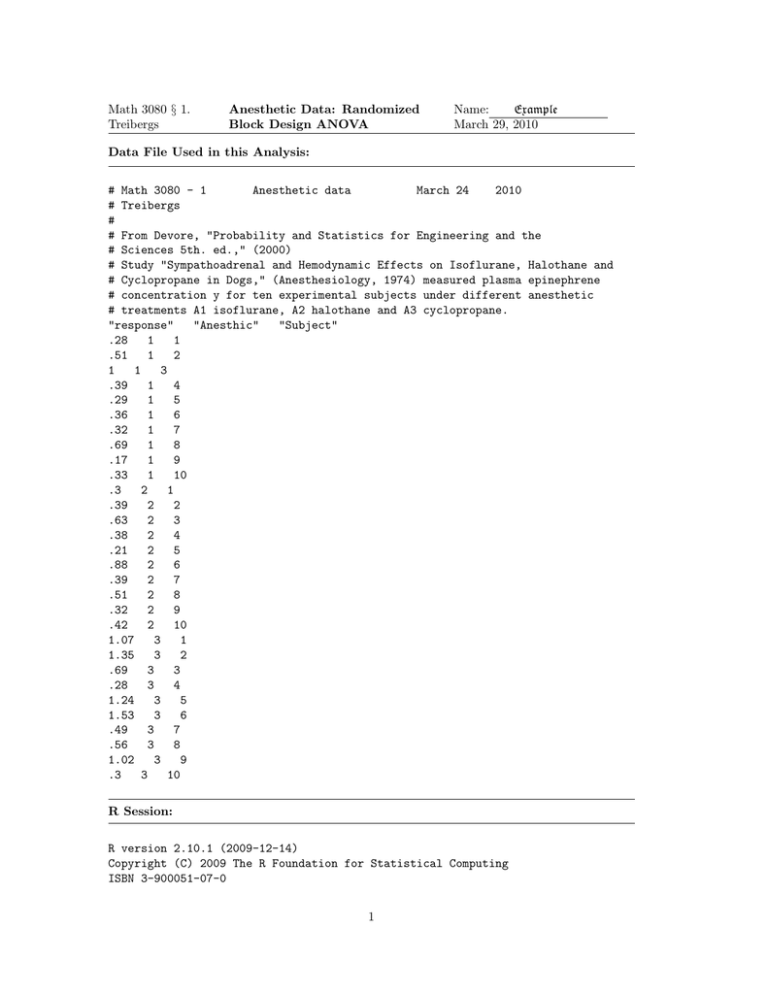
Math 3080 § 1. Treibergs Anesthetic Data: Randomized Block Design ANOVA Name: Example March 29, 2010 Data File Used in this Analysis: # Math 3080 - 1 Anesthetic data March 24 2010 # Treibergs # # From Devore, "Probability and Statistics for Engineering and the # Sciences 5th. ed.," (2000) # Study "Sympathoadrenal and Hemodynamic Effects on Isoflurane, Halothane and # Cyclopropane in Dogs," (Anesthesiology, 1974) measured plasma epinephrene # concentration y for ten experimental subjects under different anesthetic # treatments A1 isoflurane, A2 halothane and A3 cyclopropane. "response" "Anesthic" "Subject" .28 1 1 .51 1 2 1 1 3 .39 1 4 .29 1 5 .36 1 6 .32 1 7 .69 1 8 .17 1 9 .33 1 10 .3 2 1 .39 2 2 .63 2 3 .38 2 4 .21 2 5 .88 2 6 .39 2 7 .51 2 8 .32 2 9 .42 2 10 1.07 3 1 1.35 3 2 .69 3 3 .28 3 4 1.24 3 5 1.53 3 6 .49 3 7 .56 3 8 1.02 3 9 .3 3 10 R Session: R version 2.10.1 (2009-12-14) Copyright (C) 2009 The R Foundation for Statistical Computing ISBN 3-900051-07-0 1 R is free software and comes with ABSOLUTELY NO WARRANTY. You are welcome to redistribute it under certain conditions. Type ’license()’ or ’licence()’ for distribution details. Natural language support but running in an English locale R is a collaborative project with many contributors. Type ’contributors()’ for more information and ’citation()’ on how to cite R or R packages in publications. Type ’demo()’ for some demos, ’help()’ for on-line help, or ’help.start()’ for an HTML browser interface to help. Type ’q()’ to quit R. [R.app GUI 1.31 (5538) powerpc-apple-darwin8.11.1] [Workspace restored from /Users/andrejstreibergs/.RData] > tt <- read.table("M3081DataAnesthetic.txt",header=TRUE) > tt response Anesthic Subject 1 0.28 1 1 2 0.51 1 2 3 1.00 1 3 4 0.39 1 4 5 0.29 1 5 6 0.36 1 6 7 0.32 1 7 8 0.69 1 8 9 0.17 1 9 10 0.33 1 10 11 0.30 2 1 12 0.39 2 2 13 0.63 2 3 14 0.38 2 4 15 0.21 2 5 16 0.88 2 6 17 0.39 2 7 18 0.51 2 8 19 0.32 2 9 20 0.42 2 10 21 1.07 3 1 22 1.35 3 2 23 0.69 3 3 24 0.28 3 4 25 1.24 3 5 26 1.53 3 6 27 0.49 3 7 28 0.56 3 8 29 1.02 3 9 30 0.30 3 10 2 > attach(tt) > A <- factor(Anesthic) > B <- factor(Subject) >#===================================SUMMARY OF FACTOR A=============== > tapply(response,A,summary) $‘1‘ Min. 1st Qu. Median Mean 3rd Qu. Max. 0.1700 0.2975 0.3450 0.4340 0.4800 1.0000 $‘2‘ Min. 1st Qu. 0.2100 0.3350 Median 0.3900 Mean 3rd Qu. 0.4430 0.4875 Max. 0.8800 $‘3‘ Min. 1st Qu. 0.2800 0.5075 Median 0.8550 Mean 3rd Qu. 0.8530 1.1980 Max. 1.5300 > y<-response > tapply(y,A,mean) 1 2 3 0.434 0.443 0.853 > tapply(y,B,mean) 1 2 3 4 5 6 7 0.5500000 0.7500000 0.7733333 0.3500000 0.5800000 0.9233333 0.4000000 8 9 10 0.5866667 0.5033333 0.3500000 > tapply(y,A,sd) 1 2 3 0.2442767 0.1916043 0.4482571 >=====================================RUN ANOVA========================== > f1 <- aov(y~A+B);anova(f1) Analysis of Variance Table Response: y Df Sum Sq Mean Sq F value Pr(>F) A 2 1.1458 0.57290 6.1068 0.009454 ** B 9 0.9872 0.10969 1.1692 0.369730 Residuals 18 1.6887 0.09381 --Signif. codes: 0 *** 0.001 ** 0.01 * 0.05 . 0.1 > model.tables(f1,"means") Tables of means Grand mean 0.5766667 A 1 2 3 0.434 0.443 0.853 B 3 1 1 2 3 4 5 6 7 8 9 10 0.5500 0.7500 0.7733 0.3500 0.5800 0.9233 0.4000 0.5867 0.5033 0.3500 > model.tables(f1,"effects",se=TRUE) Tables of effects A 1 2 -0.14267 -0.13367 3 0.27633 B 1 -0.0267 10 -0.2267 2 0.1733 3 4 0.1967 -0.2267 5 0.0033 6 7 0.3467 -0.1767 8 9 0.0100 -0.0733 Standard errors of effects A B 0.09686 0.17684 replic. 10 3 >#=================================PLOT DIAGNOSTICS============================= > layout(matrix(1:4,ncol=2)) > plot(y~A) > plot(rstudent(f1)~fitted(f1),xlab="Predicted Values",ylab="Student. Resid", ylim=max(abs(rstudent(f1)))*c(-1,1)) > abline(h=c(0,-2,2),lty=c(2,3,3)) > plot(fitted(f1)~y,ylab="y hat") > abline(0,1,lty=5) > qqnorm(rstudent(f1),ylim=max(abs(rstudent(f1)))*c(-1,1),ylab="Student. Resid.") > abline(0,1,lty=5);abline(h=c(0,-2,2),lty=c(2,3,3)) 4 5 >#=================================TUKEY HSD============================== > TukeyHSD(f1,"A") Tukey multiple comparisons of means 95% family-wise confidence level Fit: aov(formula = y ~ A + B) $A diff lwr upr p adj 2-1 0.009 -0.34058942 0.3585894 0.9976231 3-1 0.419 0.06941058 0.7685894 0.0176670 3-2 0.410 0.06041058 0.7595894 0.0202868 >#=======================================SHAPIRO-WILK TEST FOR NORMALITY========== > shapiro.test(rstudent(f1)) Shapiro-Wilk normality test data: rstudent(f1) W = 0.9616, p-value = 0.3406 >#==========================================RUNN SAME DATA WITHOUT BLOCKING========= >#===EACH ANESTHETIC WAS GIVEN TO THE SAME ANIMALS SO THIS IN INAPPROPRIATE ANALYSIS >#=======================================THIS ANALYSIS SHOWN FOR COMPARISON========= > f2 <- aov(y~A) > anova(f2) Analysis of Variance Table Response: y Df Sum Sq Mean Sq F value Pr(>F) A 2 1.1458 0.57290 5.7807 0.008135 ** Residuals 27 2.6759 0.09911 --Signif. codes: 0 *** 0.001 ** 0.01 * 0.05 . 0.1 > TukeyHSD(f2) Tukey multiple comparisons of means 95% family-wise confidence level Fit: aov(formula = y ~ A) $A diff lwr upr p adj 2-1 0.009 -0.34007159 0.3580716 0.9977497 3-1 0.419 0.06992841 0.7680716 0.0162452 3-2 0.410 0.06092841 0.7590716 0.0188820 > 6 1
